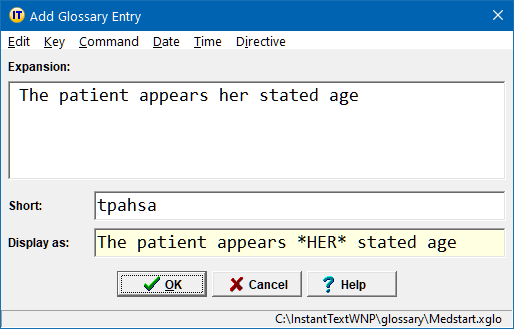Phrase Entry
In the following example, we are adding a Phrase Entry to the Current Glossary using the Add Glossary Entry window:

-
The patient appears her stated age is the expansion.
-
tpahsa is the short form.
-
The patient appears *HER* stated age is the display form.
Expansion
The expansion of a Phrase Entry is what should be produced when expanding an abbreviation for that entry. It can contain:
- text
- keys and key combinations
- commands
Short Form
The short form is the key factor that differentiates Phrase Entries from Word Entries:
-
A Phrase Entry Short Form has two or more characters.
-
A Word Entry Short Form consists of a single character.
Note that while it is natural to define phrases as Phrase Entries you may also define Words as Phrase Entries.
Display Form
The Display Form of a Phrase Entry is the text that gets displayed in the Phrase Expansion Table when the corresponding entry is proposed as an expansion candidate.
In our example we use this feature to draw the attention on her, in order to distinguish this phrase from the similar phrase with his instead of her:

The display form is optional. If you don't define one, then the expansion is displayed.
Abbreviating a Phrase Entry
In most traditional softwares, the short form is the exact abbreviation you need to type, to reach the expansion. Instant Text introduces more flexibility, by allowing you to skip letters inside the short form.
An abbreviation for a Phrase Entry requires the following:
-
it must start with the first letter of its short form.
-
It must be a subset of letters of the short form that appear in the same order.
As a result, a short form allows countless possible abbreviations to reach an expansion. Instead of defining a unique abbreviation, the short form defines a complete scope of possible abbreviations.
In our example this allows abbrevations as:
| Short | Abbreviation |
|---|---|
|
t p a h s a |
t p |
|
t p a h s a |
t p a h |
|
t p a h s a |
t p h a |
|
t p a h s a |
t p s a |
|
t p a h s a |
t h s a |